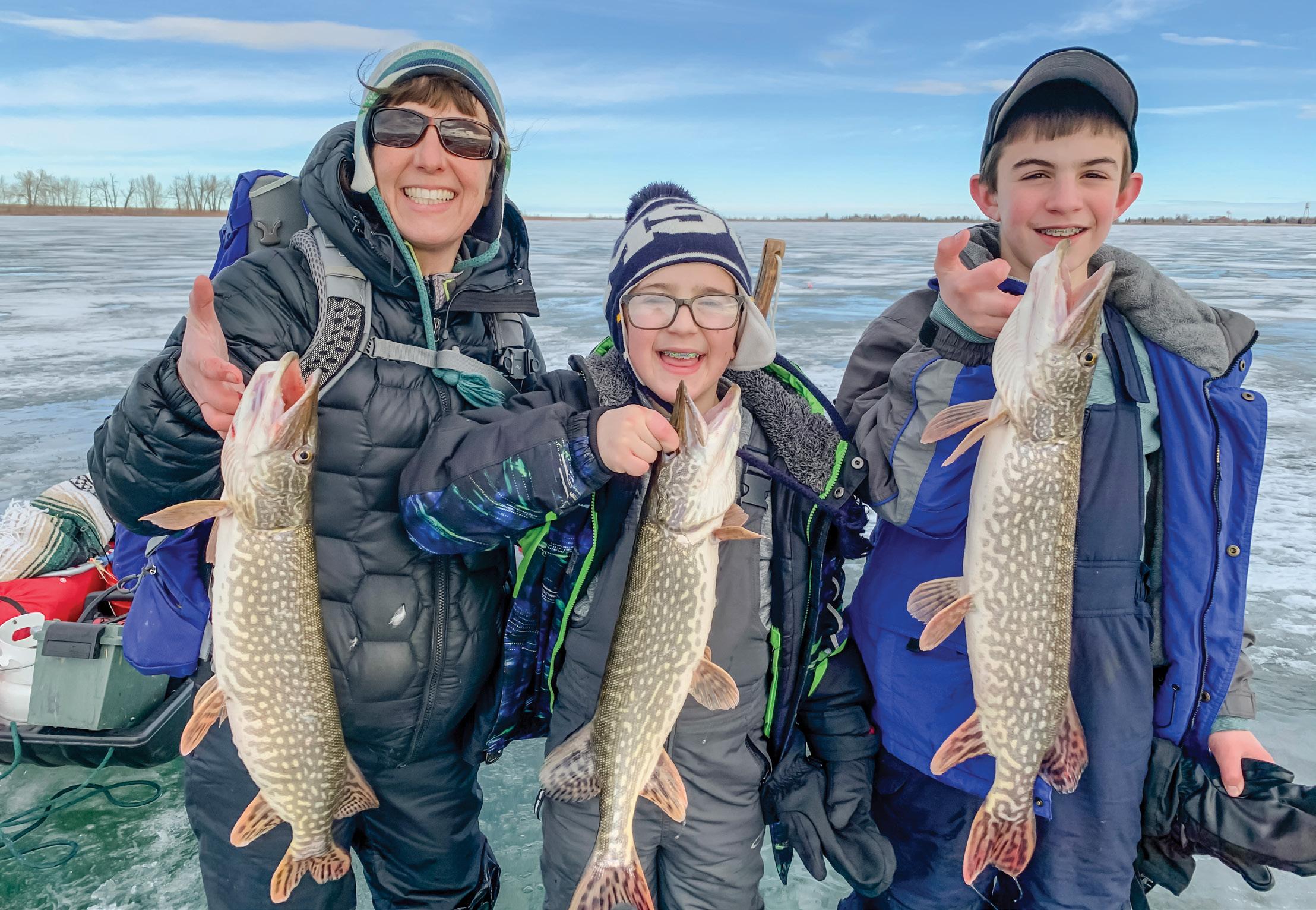
13 minute read
W fishing inter
People think we’re nuts. To the uninitiated, sitting on a fivegallon bucket on a frozen lake in the bitter cold, looking down a hole for hours couldn’t possibly be a good time. And they have a point. But sitting on a bucket in a tent warmed by our trusty propane heater while enjoying cocoa and snacks and reeling in a limit of Kokanee salmon, or perch for that matter, is a different scenario.
My husband, Grant, is a fisheries biologist by profession, and while he has his thumb on the pulse of all fishing styles, ice fishing has been his obsession since childhood. Now, he aims to share that passion with our boys, Sam, 16, and John, 14, so it’s where we spend our winter pastime. Of the most obvious wonders of ice fishing is the ice itself. It’s common to see people and houses dotting frozen lakes early in the season, and technically, anywhere with four inches of clear, hard ice is considered safe –supposedly. However, there’s no such thing as safe ice. That said, we don’t venture out until it’s at least 8 inches thick, and still use caution. I’ll likely never be comfortable with the sound the ice makes as it’s forming, despite the fact that “singing” ice is a good sign. When a crack comes screaming across the lake and makes the water jump in your fishing hole, you certainly think twice about being on the ice.
Growing up in Great Falls, Montana, Grant fished Pishkun Reservoir, Lake Francis, Tiber, Holter, and many other popular waters in the region. We met when he worked in the Flathead Valley and he introduced me to ice fishing, typically on Smith Lake west of Kalispell. Ice fishing was an inexpensive activity we could enjoy together. We couldn’t afford a tent at the time, so he built the four-foot square “Perch Palace” out of lumber, and we skidded it to our preferred location, sacking up perch in shallow waters.
Many can enjoy ice fishing as the equipment doesn’t need to be fancy. In the early days, we chose nice weather and sat outside in the sunshine on buckets. Eventually, we were gifted a couple ice houses, making it much easier to stay warm in less than perfect conditions. Mr. Heater coupled with the icehouse made it comfortable even when it was below zero or blowing, both common occurrences in the area. Aside from shelter or a bucket on a warm day, a short ice fishing rod, some Swedish pimples and maggots, and an auger is all that is needed. We have used fish finders at times to better gauge the depth of the fish, and an underwater camera is especially fun when lots of fish are busy mocking us from below as they swim up to the bait, nibble, and leave.
It’s also important to stay comfortable, so good boots and chemical hand warmers by your toes are game changers. Warm feet make the rest of the body warm as well. As with any Montana winter activity, dress in layers because it can become surprisingly warm on sunny days. “Go get good gloves. Good gloves are a necessity… and cheese curds,” Sam added, with a nod to our go-to snack for any ice fishing adventure.
Returning to Great Falls 16 years ago, Grant looked forward to fishing the excellent waters of his childhood and sharing those with our own boys. Our sons have accompanied us from a young age on ice fishing expeditions, catching everything from perch to pike.
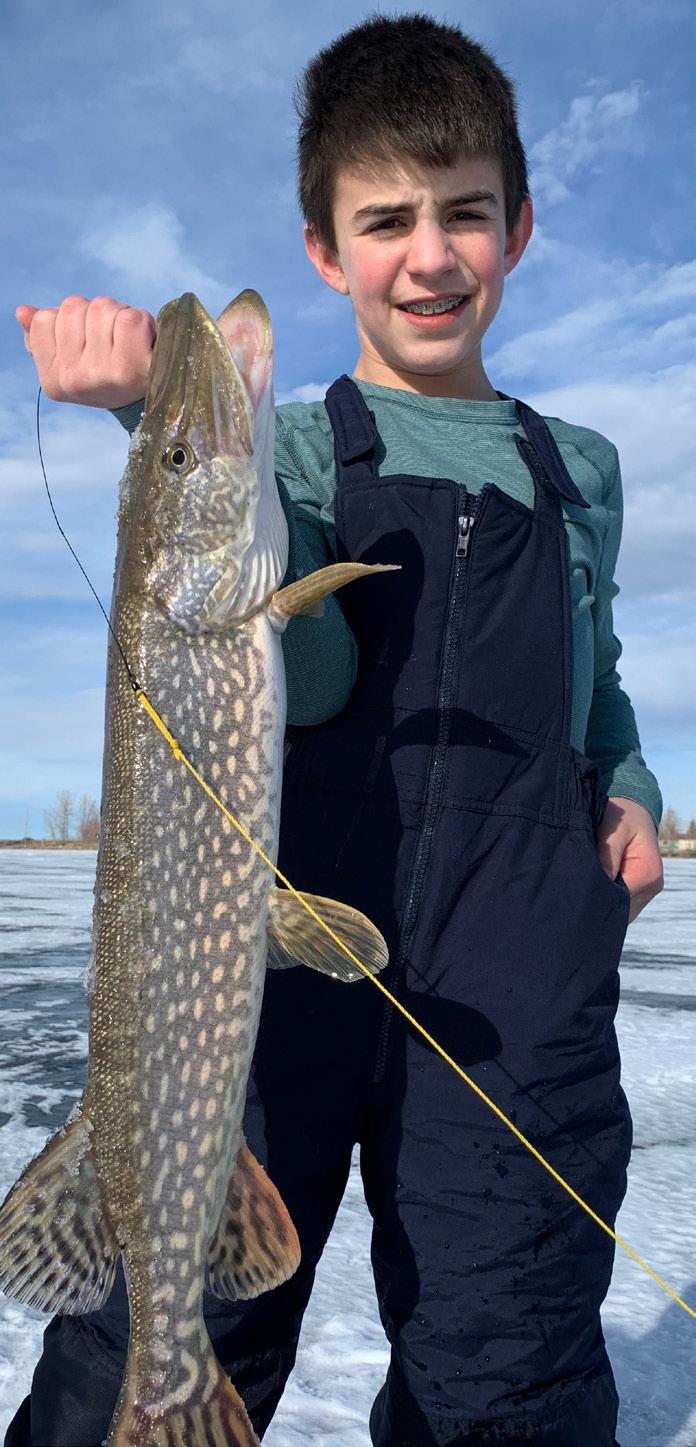
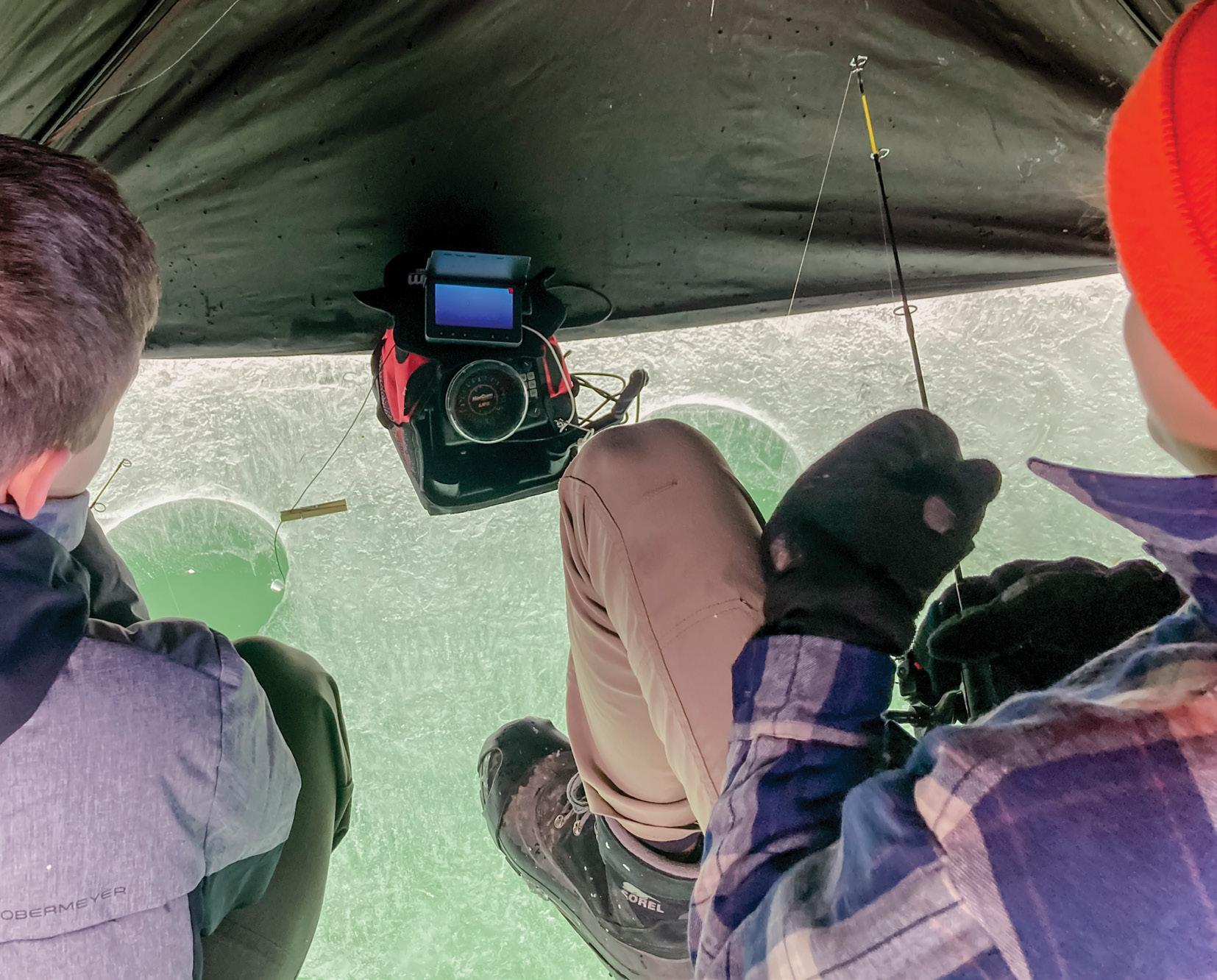
As a mother, it is admittedly nerve-racking watching kids around larger holes, so during those early days, Grant didn’t drill a hole larger than 8 inches. Even so, seemingly every trip included at least one kid landing a foot in the water, which is why I packed enough for a six-month arctic expedition – a habit I haven’t shook. The key to those early excursions was bundling in warm clothes, packing an extra change of clothes, and enjoying plenty of special treats. As soon as we were set up to fish, the boys were ready for cocoa or snacks – part of the cherished tradition as cocoa always tastes better outside.
We were often targeting perch on Holter, and the boys usually had more patience than I did jigging, mesmerized as they stared into the depths of the water. Perch fishing is enjoyable when there are lots of them, even if they’re small. However, Grant really loves going after pike and is the tipup master. Some view fishing with tip-ups as a passive means of catching them, but that’s not necessarily the case. At times, it’s a scurried frenzy running from flag to flag, especially as Grant spaces them to a distance similar running suicides during basketball practice. Still, the sight of a flag up is exciting and spurs an adrenalin rush. Sam and John both prefer pike fishing as well.
“You fight the fish differently. I like pulling the fish straight up instead of using skill,” Sam joked. John also likes pike as they’re a big, gnarly fish, and his goal is to catch one jigging on the rod. He’s experienced the fight both trout and perch can bring and looks forward to feeling a pike tug on the line.
Some years of experience taught me there is finesse involved in pulling a fish up on the tip-up. Instinctively, the boys and I would grab the line and yank it before pulling it up as fast as possible. But after rigorous coaching from Grant, we learned to wait a bit and see if the spool on top was moving, indicating whether the pike was still hooked. Then, the best practice is a sharp tug to set the hook followed by a slow pull up, avoiding tangling the line. As an expert knot creator, my priority is a fish on the ice, and I know Grant will untangle the line for me.
Some of our recent favorite fishing opportunities have been with Kokanee salmon around Helena, with varied luck. Some days present a brief flurry of activity while others see a school come through and it’s one fish after another – my kind of fishing.

While there is still ice on the lakes, grab a rod, drill a hole, and see what memories you catch with your own friends and family this winter.
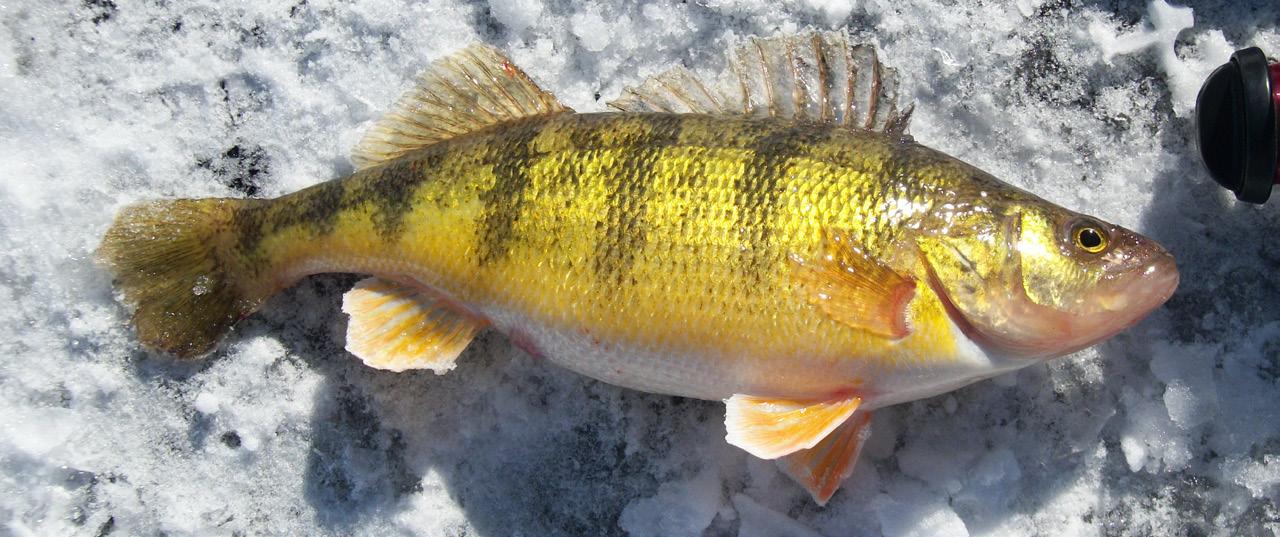
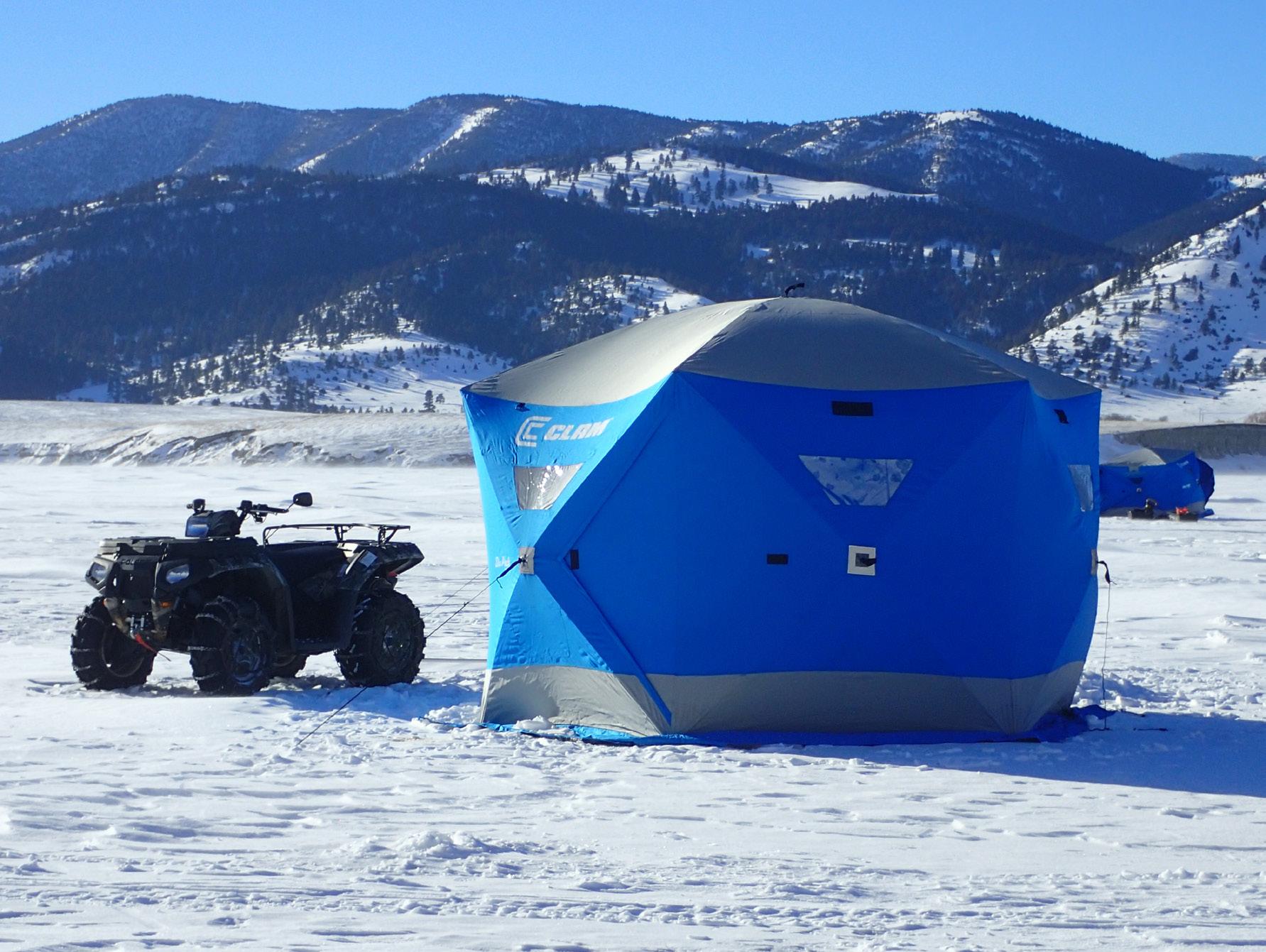
Gardeners are not patient people. Many are already perusing seed catalogs, placing orders and plotting out the 2023 gardens. For some, starting seeds is a good way to scratch the proverbial itch, but new technology has created the opportunity to grow a winter crop of herbs and vegetables without much fuss.
The greatest challenge of winter indoor gardening is lack of light. Most vegetables and herbs require 14 to 18 hours of light per day. With barely over eight hours of daylight in the dead of winter, placing plants in the windows simply doesn’t cut it.
For many years, grow lights had to be suspended on racks, consuming large amounts of space. Today, there are far more options, particularly with the rise of LED lights. Florescent bulbs were the standard choice in the past, but LEDs provide the full range of the light spectrum plants require, plus they are far more energy efficient. Of further advantage, LED lights are available in various stands and flexible configurations. For example, some lights can be bent toward a specific plant or group of plants, saving the step of hanging lights or creating an unwieldy light system.
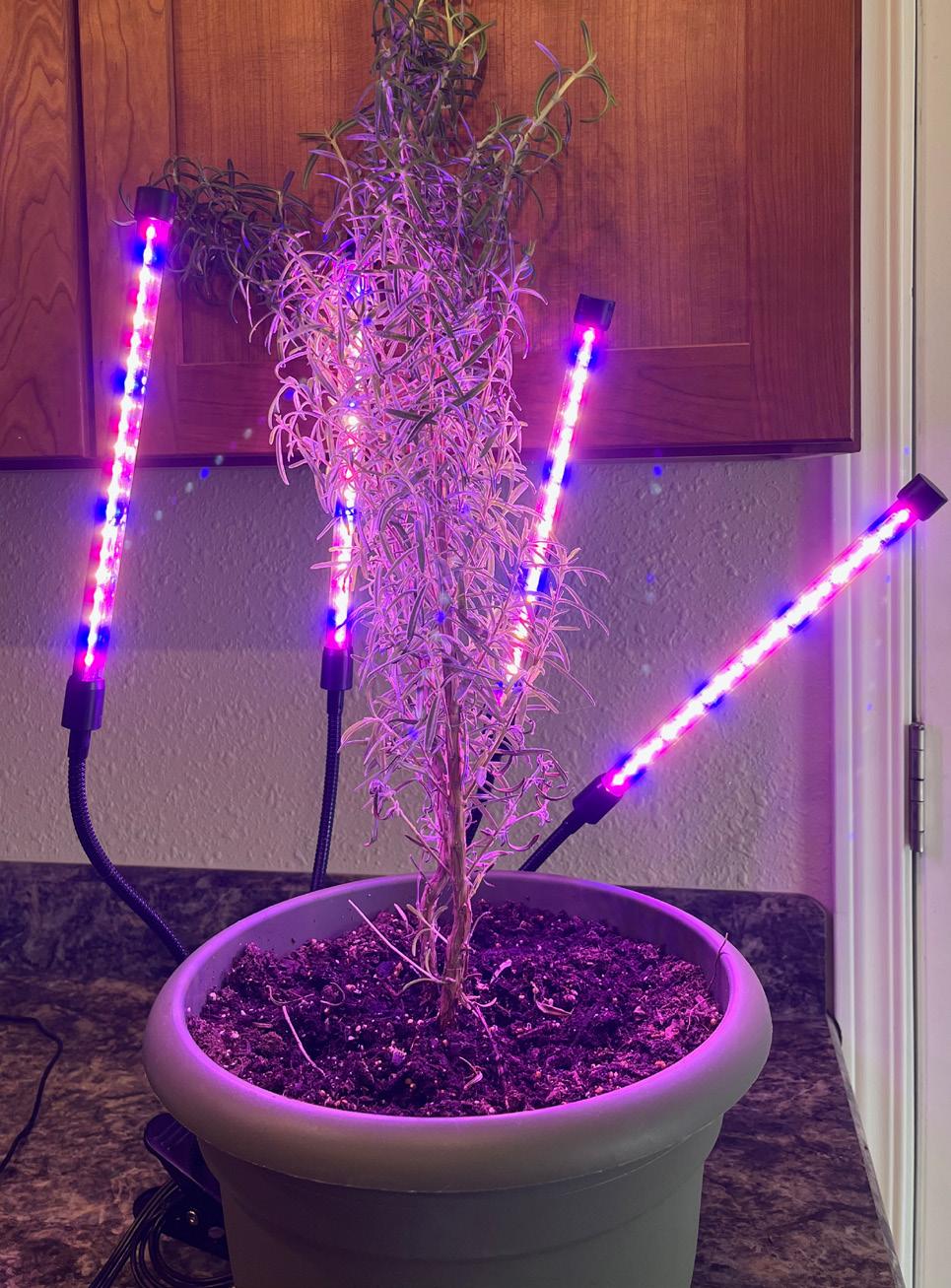
Growing plants through winter can begin at the end of the gardening season, or as a fresh start with new seedlings. Each autumn, rosemary plants can be dug up and moved inside, for instance. While rosemary grows like gangbusters during hot summers, it won’t survive the brutal winter. But if dug prior to a hard freeze and gradually acclimated to indoor conditions, there’s a better chance of a second season for the herb. Indoor rosemary, however, is fragile. Too hot or cold, too wet or dry, or even too drafty of conditions will wither the stand. Aside from providing adequate light, place rosemary away from heating vents, yet in a warm area, and water consistently. The same standards can be applied to any indoor herbs. While most are not nearly as picky as rosemary, they produce more during the off season when properly “pampered.”
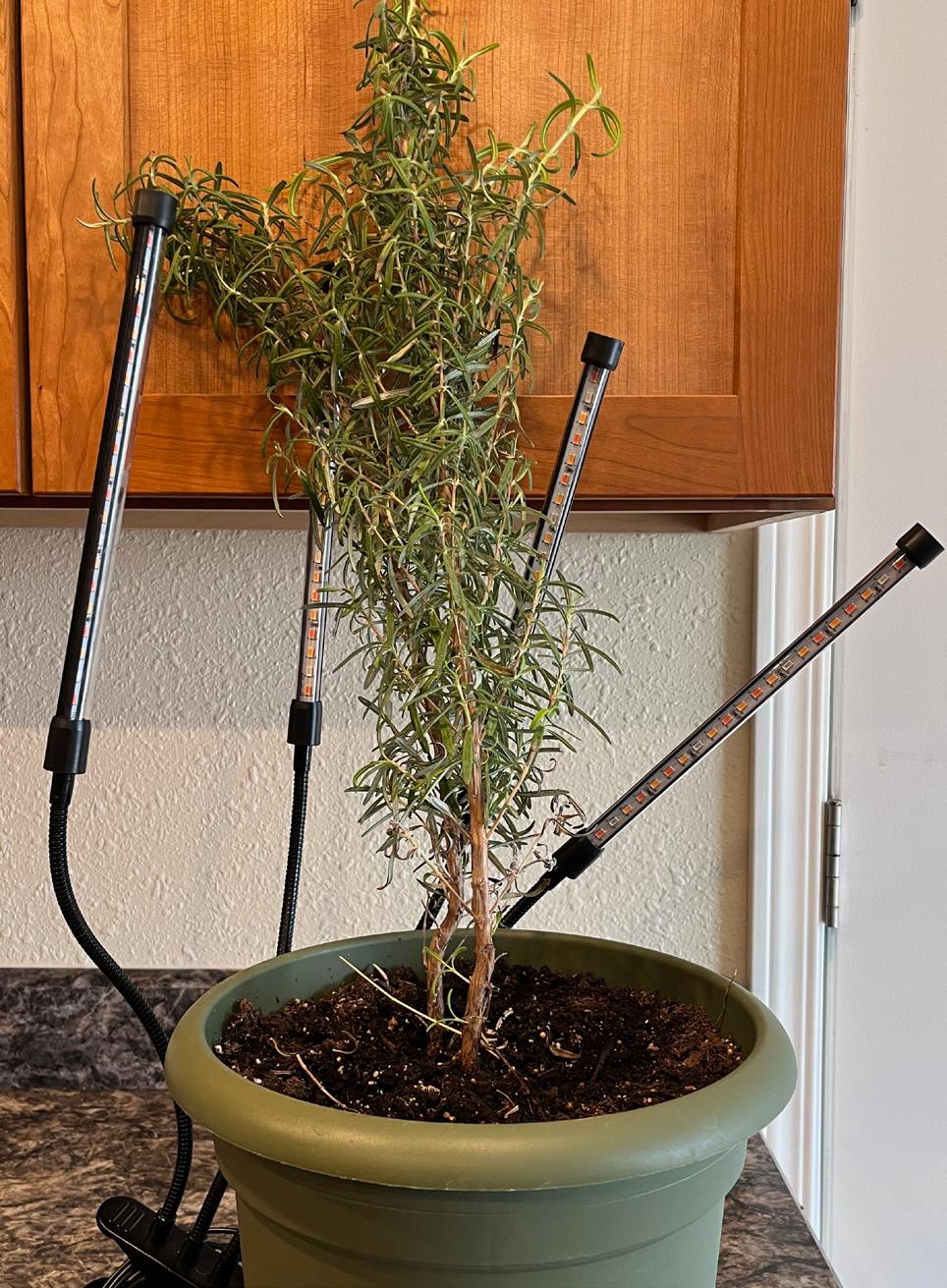
Greens are another popular option for indoor crops as they’re compact and quick growing. Planted in a container that is three to four inches deep, with seeds two to three inches apart, with enough light, even watering, and occasional water-soluble fertilizer, winter salads can be harvested in just over a month.
With the development of more container vegetable varieties, it’s now feasible to grow a small summer garden indoors. Of course, corn and pumpkins are likely off the table, but there are some terrific container varieties ranging from cucumbers to peppers.
The ‘Red Robin’ tomato has been an impressive producer. Master gardener Pat Parker and his wife, Becky, grow the plants for Ace Hardware from their home at Ulm and he suggested the tomato variety for winter gardening.
“We have grown it for about 15 years, and it is one of our favorites,” Parker said. “It does very well inside in this area. Some of our customers have kept the same plant alive for three years.”
Red Robin tomatoes are approximately one foot tall, yet provide a bounty of robin egg sized fruit. Carrie Spoonemore of Park Seed said the variety was developed by Sakata Seed in Japan in the 1970s with the goal of creating a tomato that was “small, sweet, and easy to grow.” What they didn’t realize at the time was they created a plant which would eventually be sent to space.
“NASA selected this tomato variety to grow at the International Space Station and as a control at NASA’s Kennedy Space Center,” Spoonemore explained. “The project was designed to confirm that nutritious, high-quality produce can be reliably grown in deep space, or to provide a baseline to guide the development of countermeasures to protect future crop foods from radiation during missions beyond low-Earth orbit.”
If the tomato can grow in deep space, it will grow through Montana and Wyoming winters. If Red Robin tomato plants aren’t available, the seed can be started at home by planting it in at least a two-gallon container – although a five-gallon one is best, particularly if the intention is to keep it for several seasons.


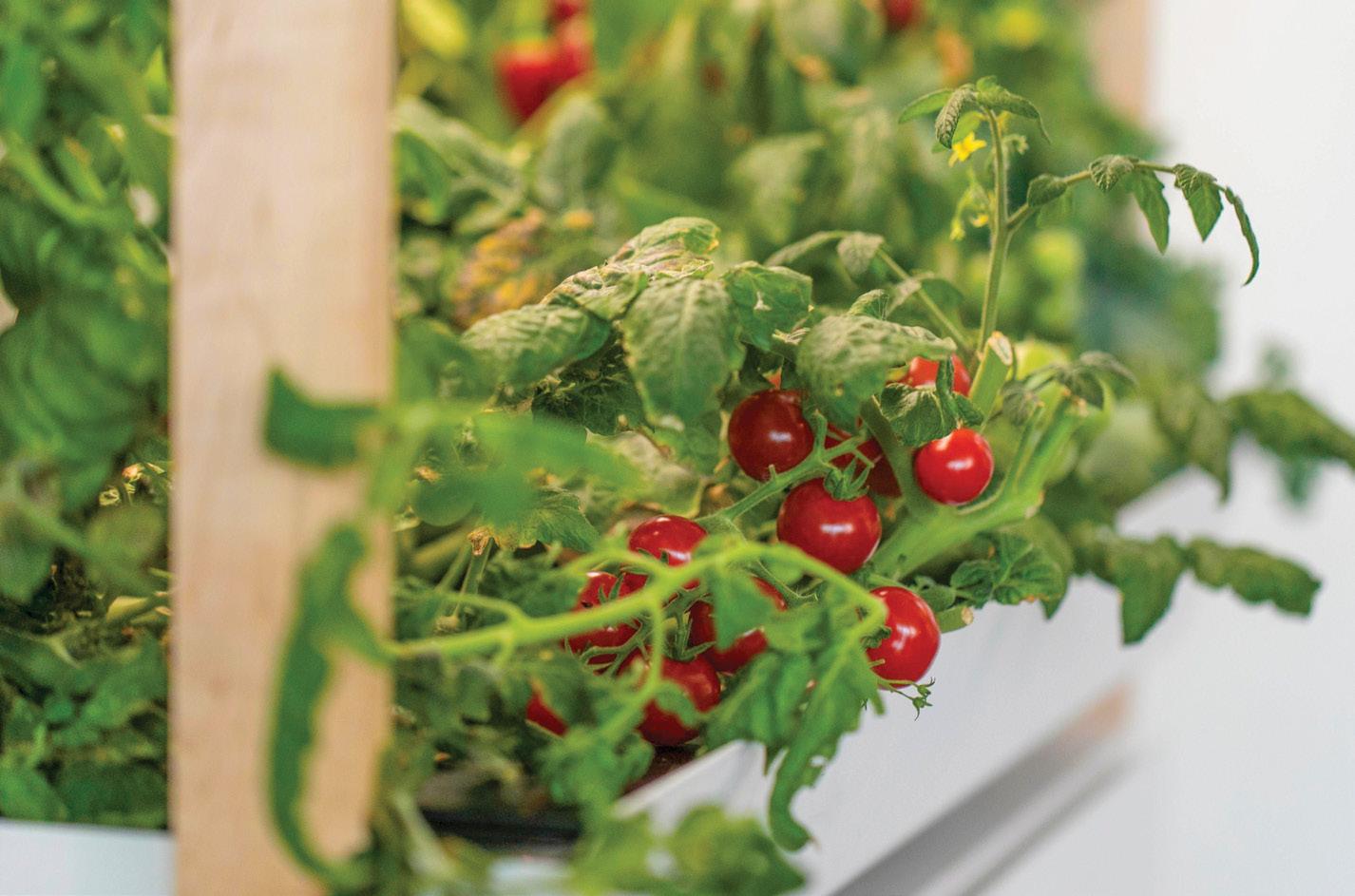
Home hydroponic units have also changed winter gardening as the systems have been simplified enough to where users of any level of experience can have success. The Rise Gardens hydroponic unit has an easy-to-use phone app that walks through the process of when to start plants, when to place them in the garden unit, when to change the water, and when to add nutrients. The light and pump are both automatic, but they can also be switched on or off from a cell phone. Once familiarized with the process, the app isn’t necessary for day-to-day use but it’s there when needed. Rise Gardens includes seeds pre-planted in pods, which are germinated outside the unit. Once there are leaves, the plants are thinned to one per pod, then placed in the hydroponic garden unit. The root growth is impressive after only a few weeks and greens are already within eating size.


By embracing new technology, northern growing seasons can be substantially extended and far more successful than those of the past when gardeners were to rely on raising sprouts in a jar for something green and fresh to eat. Today, full garden plots growing right on the countertop make for fresh, fun winter projects.

Someone once said, “if life can remove someone you never dreamt of losing, it can replace them with someone you never dreamt of having.”
The quote perfectly describes the relationship between Robert Mitchell and Gail Cushman whose paths would have never crossed had either of them failed to consciously decide to “get on with their lives.”
Gail was married to her late husband, Tom, for over fifty years. Serving as a Marine, teacher, principal, and superintendent of schools in Idaho before beginning her writing career, Gail, with Tom by her side, managed to find time to raise two children and travel the world. Her life with Tom was full and active. They loved cruises and visited all seven continents together.
Now a published author, Gail launched her writing career with a fictional series about several couples in their sixties and their comical antics. When Tom fell sick, her career was placed on hold for almost a decade as she was his primary caregiver. His passage in 2020 was an enormous loss and she asked herself “what do I do now?” For so long, her focus had been caring for her husband. Once he was gone, a void remained.
Robert Mitchell’s life shared similarities. Married to his wife, Patty, for over forty years, the adventurous couple also crossed the world in their travels. Patty was a commercial airline pilot and Robert an aircraft mechanic. He spent years as a consultant for establishing aircraft painting shops around the country and was also an expert witness in aircraft corrosion.
He and Patty owned an FBO in Belgrade before the change to raising breeding stock on their ranch in Carbon County and along the Musselshell River. Craving a grand adventure, just fourteen years before Patty’s death, the couple sold everything, bought a 48-foot boat and, for a decade, explored the Great Loop, a continuous waterway from which boaters can explore Eastern North America.
“We had a lot of fun,” Robert said. “We spent time in the Great Lakes, then on the Intercoastal Waterway up the east coast to New York.”
When that adventure had run its course, Robert and Patty settled outside of Columbus, Montana and began enjoying a slower paced life. Then Patty became sick, and Robert tenderly cared for her until she lost her battle with cancer in 2020.
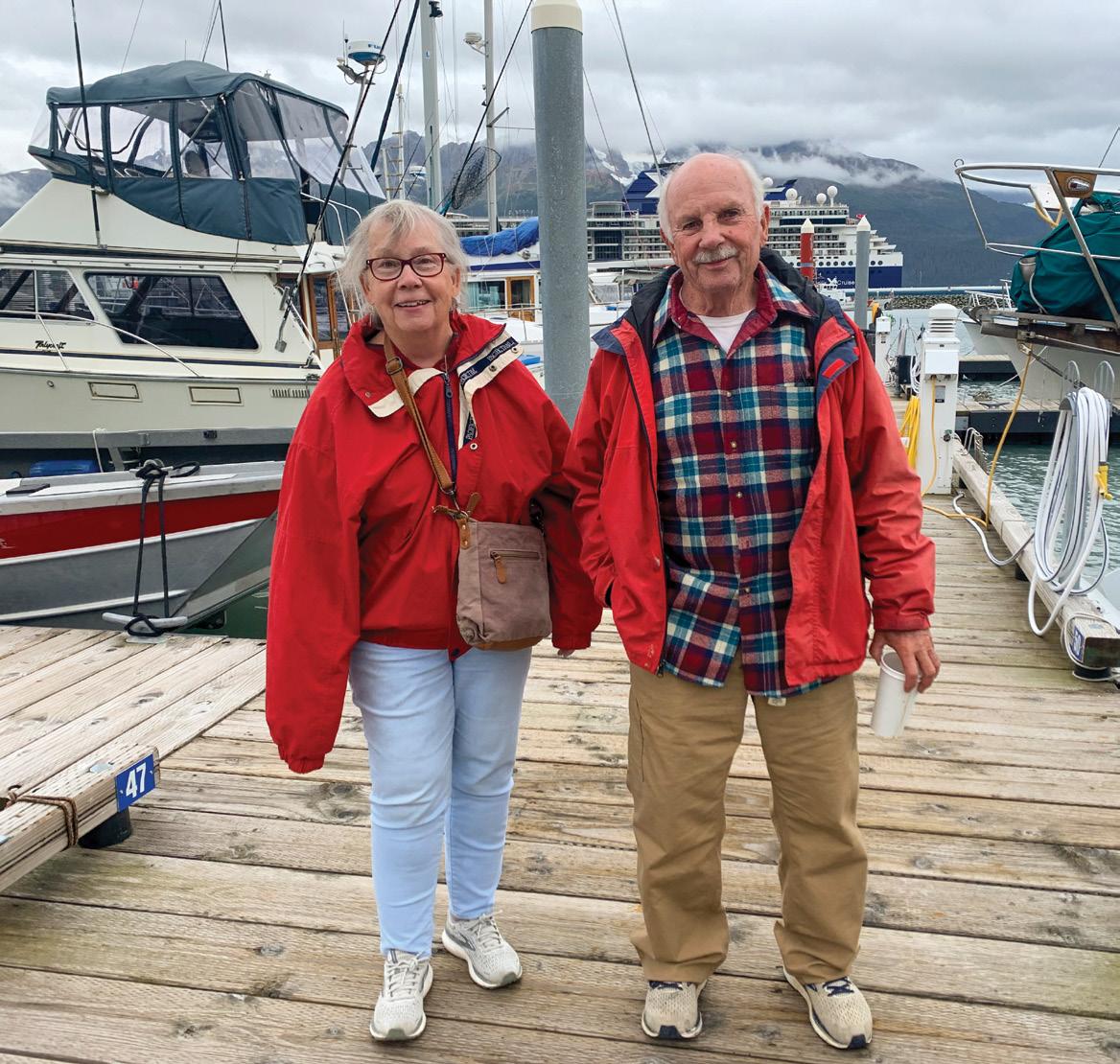
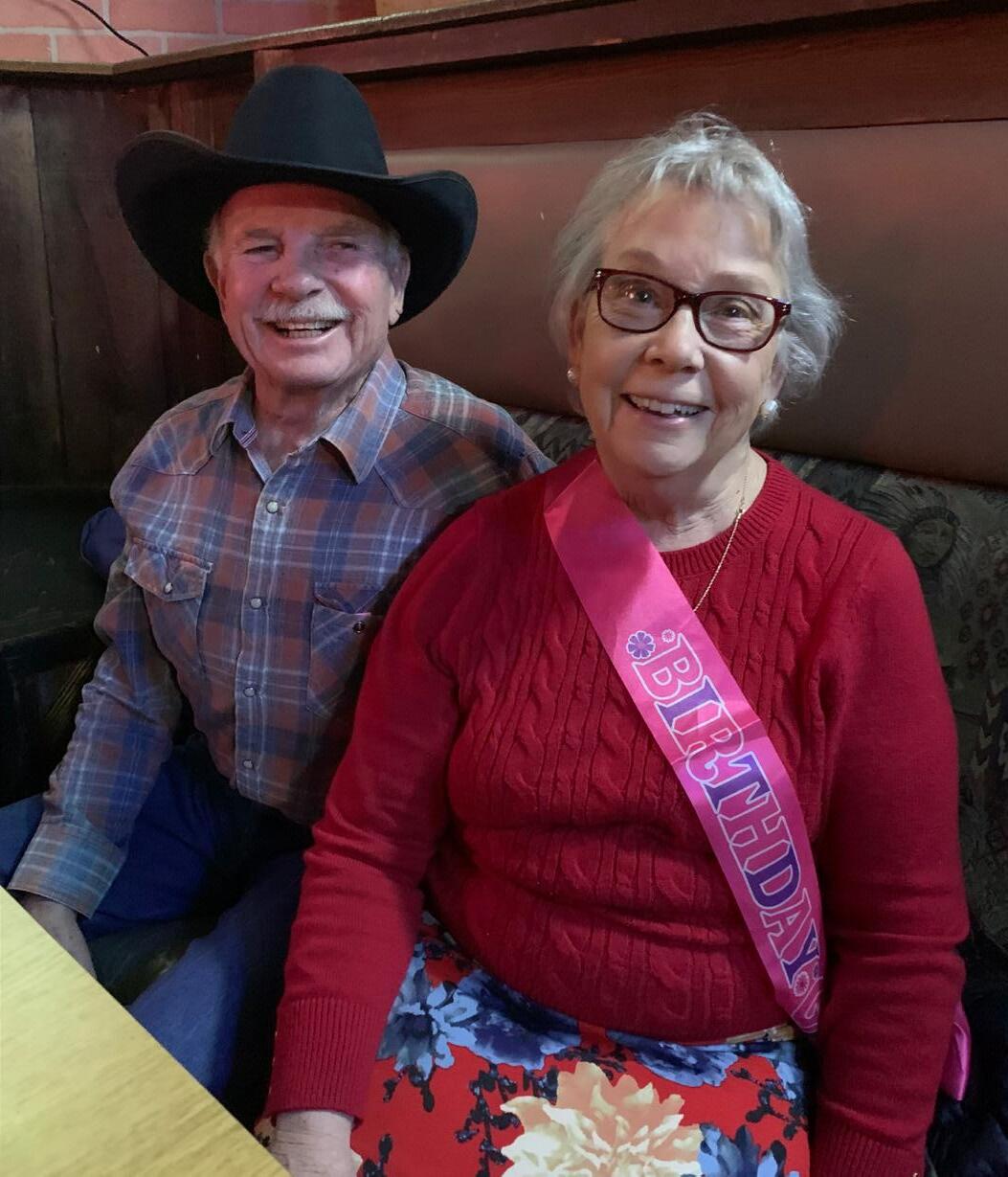
“After Patty’s death, I likened the time to the sound of silence,” Robert said. “After her funeral, I remember hoping someone would stop by or call.”

Gail agreed.
“It’s a very lonely time,” she recalled. “Especially if you’ve been caring for someone. You really do wonder what to do next.”



For Gail, with encouragement from her daughter, the next move was blogging. “Write what you know: cruises and being old,” her daughter said, half-jokingly. So, in addition to continuing to write books, she added a twice weekly, humorous blog to her repertoire and cautiously set up an online dating profile.
Six months after Patty’s death, Robert’s grandson spoke rather bluntly with him. Robert felt stuck and knew if he didn’t do something he would stay stuck. His grandson simply said to him, “Get a grip, Grampa. It’s time to start living again.”
Without a clue as to how to “start again,” Robert, too, decided to try online dating. He gathered several humorous memories from dates before meeting Gail.
“Her picture stopped me first,” he said, his eyes twinkling. “What a nice-looking lady.”
Gail laughed and said she took it very slowly when Robert reached out to her.
“For months we messaged through the site and then by text, finally phone calls,” she explained.
When they decided to meet, it took sacrifice from both as they lived 600 miles apart. At an agreed upon restaurant, halfway between Boise, Idaho and Columbus, Montana, Gail waited. She promised herself, “if he’s fifteen minutes late, I’m leaving…”
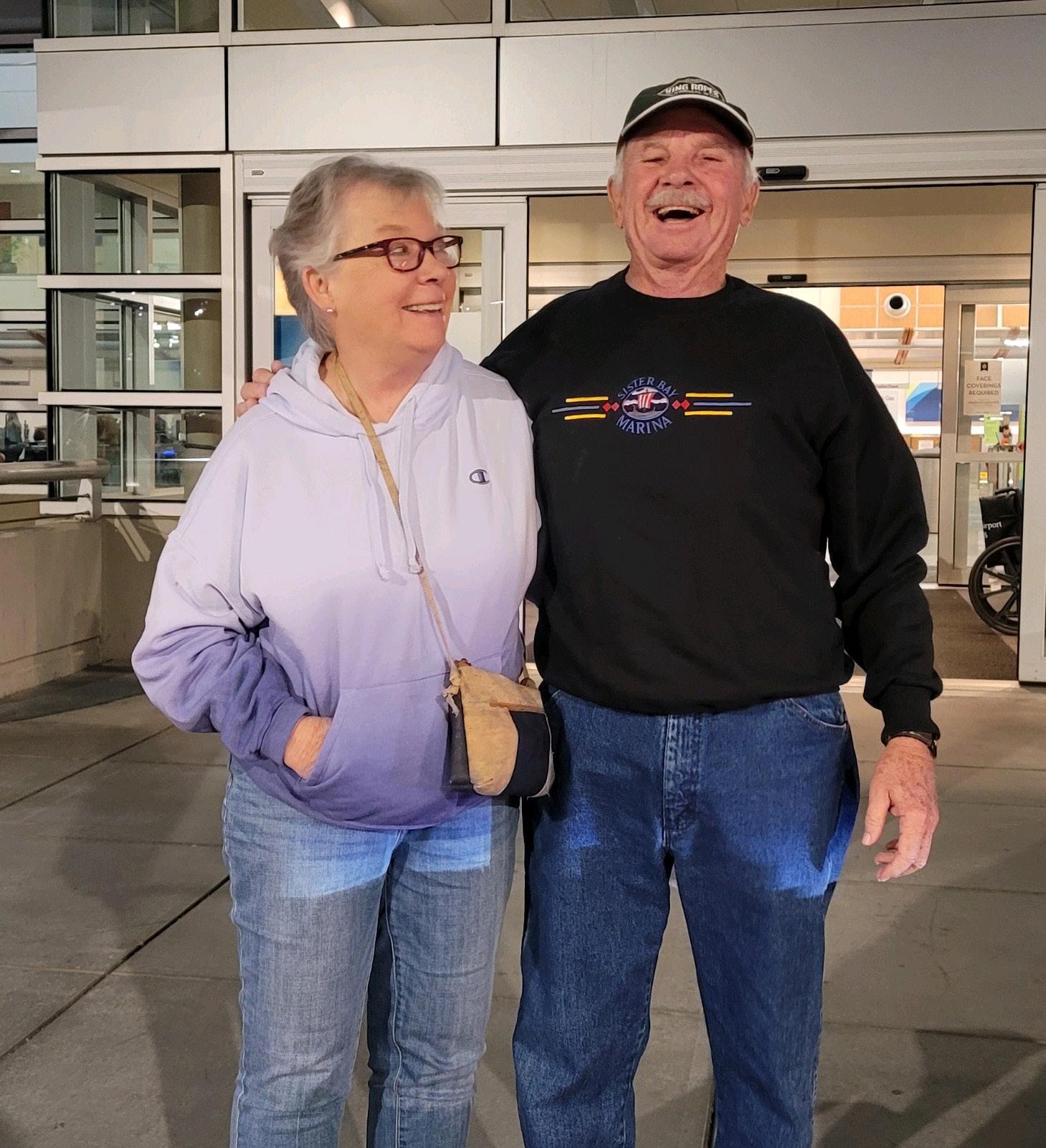
He wasn’t and she didn’t.
“He said, (to the server), ‘we are internet dating, and this is our first date,’ and picked up my hand and kissed it. My eyes got big, but I didn’t say anything,

‘First date? You guys are a little old for a first date’ the server said. Her badge read Trainee, and her accompanying trainer punched her in the arm. She corrected herself, ‘well, you can’t be too old to try something new.’
True, I’m 75 and he’s 77. Do you think we are too old for going on a date?’ I said, smiling, wondering what to do about my hand, which had moved to his cheek, but I was uncharacteristically silent." Written by Gail in a blog post about meeting Robert.






Gail’s blogs have since shared of many aspects of their relationship from the trepidation of dating and their mutual decision to take the next step to her choice to sell her home in Boise and move to Columbus and the many conversations about their families and how they would accept, or not, their growing bond.
“We might have moved fast,” Robert said. “But we’re not going to get any younger.”
In an unexpected twist to their journey, Robert started blogging along with Gail. His humorous stories, in which he pokes fun at himself, offer historical accounts of Carbon County folks and perspective on his relationship with Gail.


“My Idaho lady, Miss Gail, who most of you know writes books as the Wrinkly Bits series and her blog, is a heck of writer. She wrote and published four books and has about four or five more written but not published. She is a bundle of energy, smart, sassy, and beats me in Scrabble with both eyes closed." He wrote in his portion of the blog on which he signed off, ‘Cowboy Bob.’
Now, the two have collaborated and are in the process of writing a book together entitled “Widows and Widowers, Dancing with a New Partner,” a humorous, yet serious guide to senior dating. In it, the two share their love story about how two happily married people were suddenly left alone and death and grief took over their lives. They share about how they picked up the pieces and made the decision to do something about their loneliness, how they met and fell in love over the internet, and how laughter and adventure became part of their lives once again. Their hope is that others in the throes of loneliness will find encouragement in their story and utilize their suggestions on the top dating sites for seniors and how to cautiously move forward.
“There’s a lot of ‘I wish I would have…’ when you lose your spouse,”
”My saving grace is know how to make her laugh and sometimes can distract her when I play a word like quzt and give her a meaning that she must find in the dictionary. Anyway, this old cowboy tries to keep up with that young lady and after I did a few blogs, I found I
Robert said. “We have been given a second chance. Romance is a wonderful way to make you feel alive.”
“So, these two old fools are headed for adventures, come hell or high water, although she added no ice climbing, snowshoe camping, or naked sky diving. No ladders, no driving over triple digits, and a few more. Well, a man has to give a little, and she is doggone sure worth giving up one or two of those, and I had to agree about the ladder thing, but the rest, what she doesn’t know won’t hurt her,” Cowboy Bob wrote in his joyous outlook for the future.










